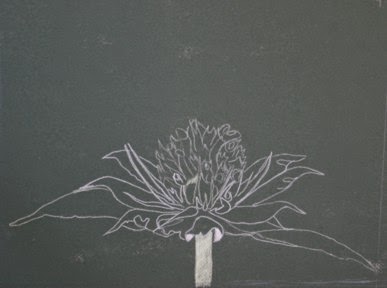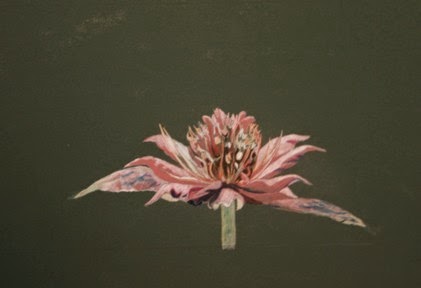Working with colored pencil can be very rewarding. There is so much you can do with it, and so many supports you can use!
Of course you have plain white paper. Plain? There are so many shades of white that you are not limited to a single value. And there are other supports. And other colors.
Each has their advantages and problems.
Bee Balm on Dark Green Mat Board
 Working on a dark support, you cannot simply save your whites, but have to "come back" to them. Also, to have intense colors, you need to give them support. Here is where we learn why canvases are traditionally painting white Gesso!
Working on a dark support, you cannot simply save your whites, but have to "come back" to them. Also, to have intense colors, you need to give them support. Here is where we learn why canvases are traditionally painting white Gesso!You can try and do your fine sketching with traditional pencil, but there is the danger of embossing the support trying to make out dark lines.
White makes a much better sketch. Always use a very sharp pencil and press lightly. If you are careful not to press down, you can erase, or use erasable pencils.
In a drawing like this I will do the entire main or focal point in an underpainting of white. This will allow the greatest contrast with the dark background. White is the most reflective color and will add vibrancy to the layers of reds and greens going over it.
 It will take multiple layers to get to any real vibrancy in this painting. Starting with the lightest reds and building up to the darker reds, blending each layer in, first with pencils, blending pencil then with a stump. Layer after layer until the colored pencil more closely resembles an old painting. At times I do use mineral spirits. But more with stump and wax blending pencil.
It will take multiple layers to get to any real vibrancy in this painting. Starting with the lightest reds and building up to the darker reds, blending each layer in, first with pencils, blending pencil then with a stump. Layer after layer until the colored pencil more closely resembles an old painting. At times I do use mineral spirits. But more with stump and wax blending pencil.Even though the background is not the focus of the artwork, it does not mean it is not important. You need to decide just how you are going to handle it, what emphasis it will have. The background not only sets the mood of the piece, but supports the main focus of the artwork. Do not neglect this. The tendency with a dark background is to simply let it go. But choose to allow your background to support the composition.


No comments:
Post a Comment
Did you enjoy this post? I would love to hear from you